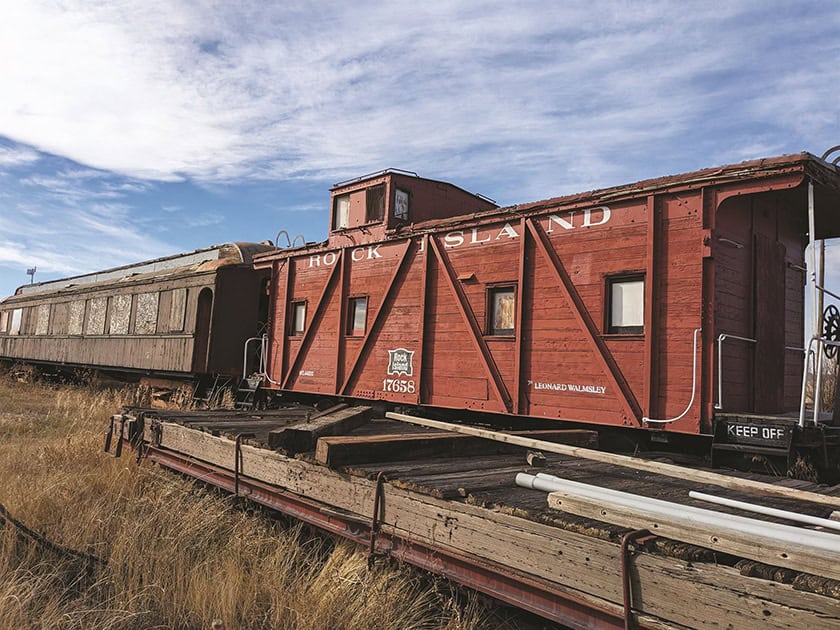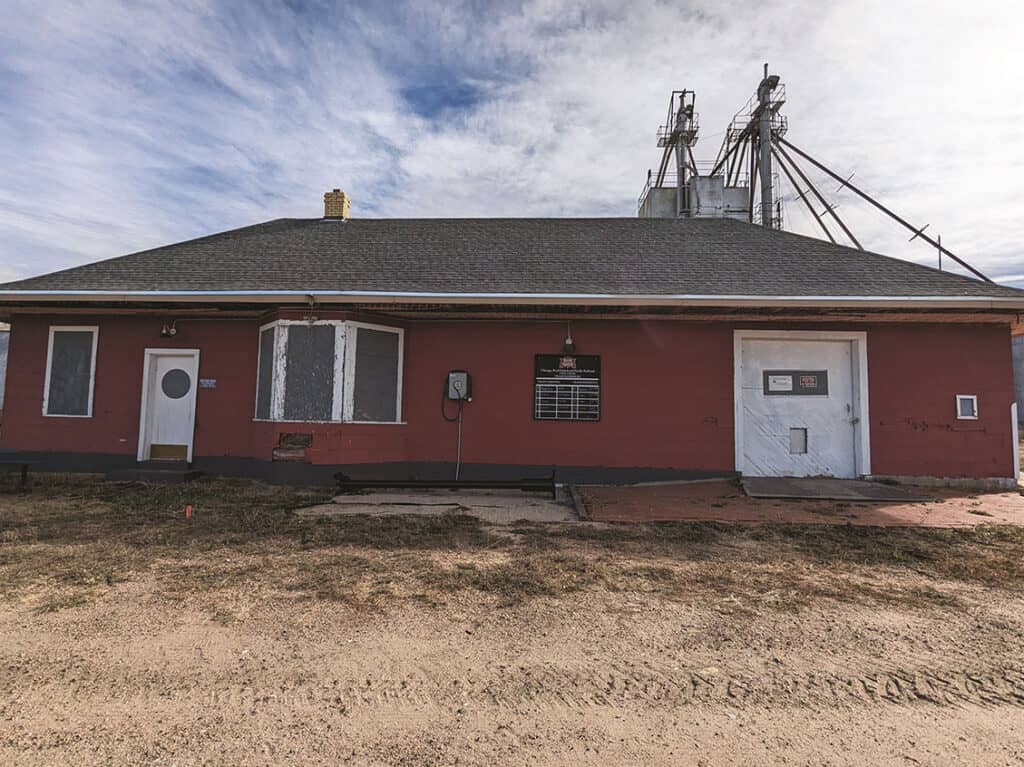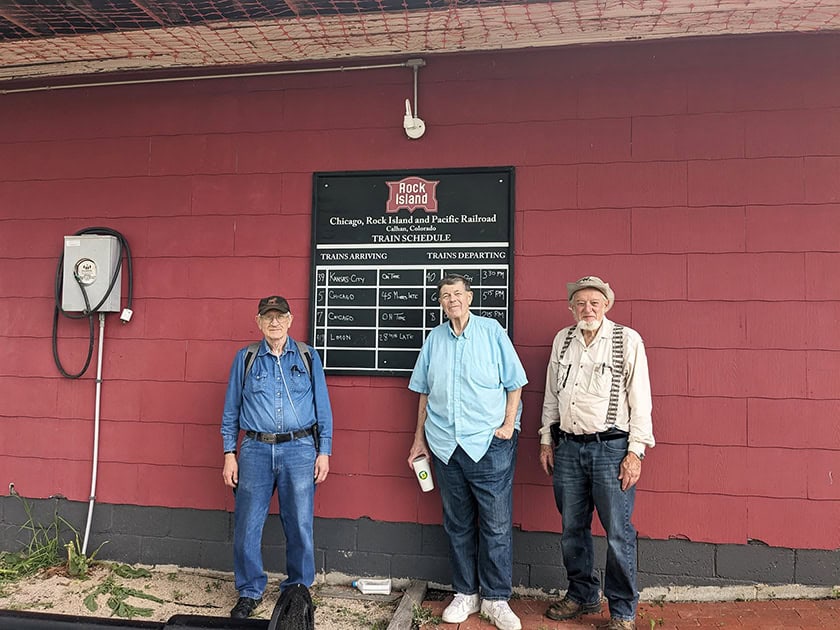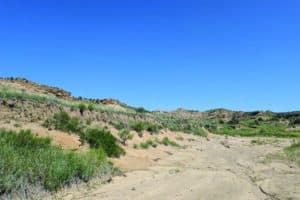Coben Scott is a history graduate, a history buff, and he has explored and researched much of Falcon and the area’s past. Coben will be writing a column for the NFH on the history of the plains that will be published every other month.
Calhan Depot Restoration
By Coben Scott
In June, the Rocky Mountain Railroad Heritage Society met up at the Calhan depot for minor renovations — attending were Jim Jordan, board president; Doug Cohn and John Emmot, board members.
Jordan’s family dates back to Colorado Springs in the pre-Civil War era; his family owned large portions of the current Red Rock Canyon Open Space Park. Cohn is another Colorado native and author of “Englewood’s Amazing Story,” a history book about the town of Englewood, Colorado. John Emmot, a retired colonel, was born and raised in Kansas and came to Colorado Springs in the 1970s. Together, these three men are essential members of the Heritage Society.
Over the years, the Rocky Mountain Railroad Heritage Society has attempted to tackle other train depot restorations in towns such as Craig, Dumont and Englewood; however, Calhan has been their priority since 2013.When the organization approached the city of Calhan, offering to fix up the old train station, the town loved the idea and sold the land and structures for a grand total of $50. The RMRHS got to work. They painted the depot back to its original “Rock Island Red,” had a new roof put on and were able to get three train cars donated by other locomotive organizations: two cabooses from the Rock Island Railroad and a first-class coach car from the Colorado and Southern Railroad. Both railroads passed through Falcon at one time. One of the cabooses was made in the late 1930s as a box car, but converted to a caboose during World War 2. The coach car is just a year older than the depot itself, dating back to 1905.

The Rock Island Railroad cars: Three train cars were donated to Calhan: two cabooses from the Rock Island Railroad and a first-class coach car from the Colorado and Southern Railroad. Both railroads passed through Falcon at one time.
Calhan as a town was spawned from the railroad similar to many others along Highway 24, the Rock Island Railroad specifically. Because of the aquifer below the depot, it created a water station stop for the line. After the depot was built, the town quickly became established in 1888. Calhan gets its namesake from one of the railroad employees who worked on this stretch, Michael Calahan. The train station opted for Calhan to save on letters and space.
At the turn of the 20th century, Calhan changed its depot to the one standing today. Before the current depot, there was once a two-story structure used as the Calhan train station, but in 1906, the town downgraded their stop for a simpler one. The building consisted of a waiting room, ticket booth and storage room. In 1935, it was remodeled to feature a telephone line among other small changes. After some flooding and the popularity of automobiles, eventually, the train stopped coming through for some time. The rail would have a last breath for a few years in the late 1980s when purchased by the Caddilac and Lake City Railway Co. This line would bring people into Calhan on the train to the county fair. This was short-lived, however, as the tracks would be sold for scrap in 1994. After its lack of use, the depot became a run down eyesore for most people.

Jordan saw more than that when he went out looking for old train stations to preserve. Jordan said, “Some people will look at it and say it’s junk, but to me it’s history, history that needs saved.” The vision with the depot is big. Jordan and Cohn explained that they want to make another attraction for Calhan. Cohn said, “The town has the Paint Mines and county fair, but not much else to see or do.” With the depot restored, they plan on having a heritage city park, a place for farmers’ markets, field trips and picnics.
The organization wants to open the inside of the depot to the public for education and have the outside be a historical playground for all ages. Talks of painting the coach car back to its original green and potentially converting it into a coffee shop are on the table. Putting up a decorative water tower where the original once stood is high on the to-do list. Encapsulating graffiti done by the original workers back in the 1920s behind plexiglass is another idea. For now though, smaller projects take priority. Getting new soffits for the roof is the next big step, repairing broken windows and cleaning up spray paint done by vandals is also in the works, and most tedious of all is getting rid of all the weeds that keep coming up.
The organization is burdened with a lack of help and money. At once, there were more than 100 members in the organization, but the numbers have dropped to double digits. The group tries to draw attention to their project, getting support from other organizations in the state. At one point, Fort Carson sent out soldiers to aid in the process. The best way to get support comes from model train expositions. Emmot is in charge of that side of the RMRHS, since he grew up with model trains in his family. “I’ve been a railroader all my life,” Emmot said. At these conventions, the organization sells Rock Island-themed calendars, coffee mugs and posters.
Despite their struggles, the group has always made an effort over the years. Whether they have three people outside pulling weeds or an entire army laying bricks, Jordan said, “We do what we can with what we have.”

Members of the Rocky Mountain Railroad Heritage Society have big plans for the old train depot: (from left to right, John Emmot, Jim Jordan, Doug Cohn).




